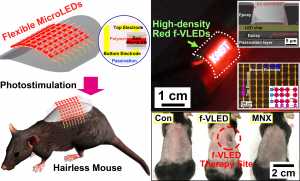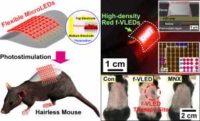
19 Sep Experimental Cap Regrows Hair Using Photostimulation
MedicalResearch.com Interview with:
 Han Eol Lee Ph.D.
Han Eol Lee Ph.D.
Flexible and Nanobio Device Lab.
Department of Materials Science and Engineering
KAIST
MedicalResearch.com: What is the background for this study?
Response: Numerous people around the world have suffered from alopecia, which leads to aesthetic issues, low self-esteem, and social anxiety. With the population expansion alopecia patients from middle-age down even to the twenties, a depilation treatment is expected to have social and medical impacts on billions of patients. The causes of alopecia are generally known to be heredity, mental stress, aging, and elevated male hormone. Therapeutic techniques such as thermal, electrical, pharmacological, and optical stimulation have been proposed to treat hair problems. Among them, laser stimulation to hair-lost regions is a promising technique, activating the anagen phase and the proliferation of hair follicles without side effects. However, this laser stimulation technique has drawbacks, such as high power consumption, large size, and restrictive use in daily life (e.g., the difficulty of microscale spatial control and the long time exposure of high-energy laser).
MedicalResearch.com: What is the background for this device?
Response: Our group has studed flexible thin-film vertical micro light-emitting diodes (f-VLEDs) of both blue and red light with high stability and outstanding power efficiency. These flexible μLEDs are suitable for human-interface applications, due to its biocompatibility, portability and excellent stability. In particular, periodic irradiation of a red light of our μLEDs on hairless area can assist localized stimulation of hair follicles under the skin, because these waves can deeply penetrate the skin tissue, compared to the short wavelength light of blue and green light.
MedicalResearch.com: What should readers take away from your report?
Response: Recently, microLEDs have been spotlighted as a key technology for the future full-color displays, due to their excellent optical properties (e.g., hue, brightness, saturation and contrast values), low power consumption, short latency time, long lifespan, and high stability in harsh environmental conditions. Furthermore, f-VLEDs have various advantages for biomedical and wearable applications (optogenetic stimulation, SpO2 sensor, dermatology therapy, etc), such as high light output power, low power consumption and low heating.
MedicalResearch.com: What recommendations do you have for future research as a result of this work?
Response: Our red f-VLED stimulator was implemented on the dorsal skin of the depilated mice, enabling hair-growth photostimulation. The hair-growth of the depilated mouse was promoted by periodic irradiation of red light for 20 consecutive days. After the red f-VLEDs were irradiated to the mouse skin, the rapid hair growth was observed in the extracted mouse skin without any thermal/inflammatory tissue damages. This approach confirms that our red f-VLEDs are powerful tools for real-time phototherapy applications. Additionally, the hair-growth in dead hair follicles should be investigated by collaboration used together with stem cell modulations. Clinical trials should also be conducted in connection with these experiments.
Citation:
Han Eol Lee, Seung Hyun Lee, Minju Jeong, Jung Ho Shin, Yuri Ahn, Daesoo Kim, Sang Ho Oh, Seok Hyun Yun, Keon Jae Lee. Trichogenic Photostimulation Using Monolithic Flexible Vertical AlGaInP Light-Emitting Diodes. ACS Nano, 2018; DOI: 10.1021/acsnano.8b05568
[wysija_form id=”3″]
[last-modified]
The information on MedicalResearch.com is provided for educational purposes only, and is in no way intended to diagnose, cure, or treat any medical or other condition. Always seek the advice of your physician or other qualified health and ask your doctor any questions you may have regarding a medical condition. In addition to all other limitations and disclaimers in this agreement, service provider and its third party providers disclaim any liability or loss in connection with the content provided on this website.
Last Updated on September 19, 2018 by Marie Benz MD FAAD
